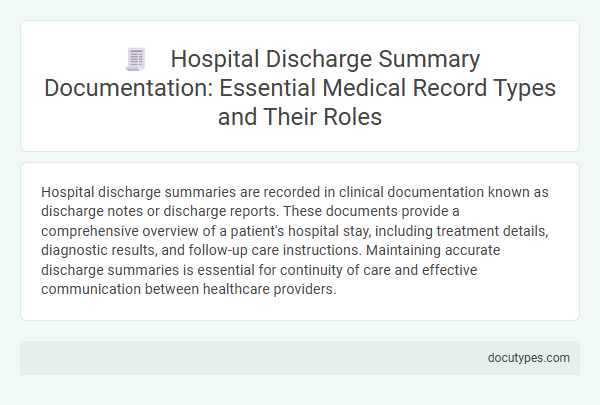Hospital discharge summaries are recorded in clinical documentation known as discharge notes or discharge reports. These documents provide a comprehensive overview of a patient's hospital stay, including treatment details, diagnostic results, and follow-up care instructions. Maintaining accurate discharge summaries is essential for continuity of care and effective communication between healthcare providers.
Introduction to Hospital Discharge Summaries
Hospital discharge summaries are essential medical documents that provide a comprehensive overview of a patient's hospital stay, treatment, and follow-up care instructions. These records ensure continuity of care by communicating critical information to outpatient healthcare providers.
Discharge summaries include details such as diagnosis, procedures performed, medications prescribed, and recommendations for further treatment. They are typically documented in the official hospital medical record system under the "Discharge Summary" or "Hospital Discharge" document type. Accurate and timely discharge summaries help reduce readmission rates and improve patient outcomes by facilitating coordinated post-hospital care.
Key Components of Discharge Summary Documentation
Hospital discharge summaries are typically recorded in the Medical Summary Report or Discharge Summary Document within a patient's medical record. These documents serve as essential communication tools between hospital staff and outpatient care providers.
Key components of discharge summary documentation include patient identification, admission and discharge dates, and primary diagnoses. The summary also details treatments administered, medications prescribed at discharge, follow-up instructions, and recommendations for further care.
Types of Hospital Discharge Summaries
| Document Type | Description | Purpose |
|---|---|---|
| Standard Discharge Summary | A comprehensive record documenting the patient's hospital stay, diagnosis, treatment, and follow-up instructions. | Serves as the primary communication tool between hospital and outpatient healthcare providers. |
| Short Discharge Note | A concise version of the discharge summary focusing on essential information like diagnosis, treatment, and medications. | Used for uncomplicated cases or brief hospital stays requiring minimal follow-up. |
| Detailed Discharge Report | Includes extensive clinical data such as lab results, imaging, consultations, and patient progress notes. | Designed for complex cases demanding thorough documentation for ongoing care. |
| Electronic Discharge Summary | A digital format document accessible via electronic health record (EHR) systems. | Enhances the speed and accuracy of communicating discharge information to relevant healthcare team members. |
| Patient-Centered Discharge Instructions | Focuses on clear, understandable guidance tailored for patients and caregivers post-discharge. | Ensures you understand medication regimes, lifestyle changes, and follow-up appointments. |
Importance of Accurate Medical Recordkeeping
Hospital discharge summaries are documented within the patient's medical record, typically classified under clinical reports or discharge documentation. These summaries provide a comprehensive overview of a patient's hospitalization, diagnosis, treatment, and follow-up care instructions.
Accurate medical recordkeeping in discharge summaries is crucial for ensuring continuity of care and facilitating communication among healthcare providers. Precise documentation helps prevent medical errors, supports legal compliance, and improves patient safety and outcomes.
Role of Discharge Summaries in Continuity of Care
Hospital discharge summaries are critical documents that record detailed information about a patient's hospital stay and treatment. These summaries are essential for ensuring continuity of care after a patient leaves the hospital.
- Discharge Summary Document - This document records key details of a patient's hospital admission, treatment, and discharge instructions.
- Role in Continuity of Care - It facilitates effective communication between hospital teams and primary care providers for ongoing patient management.
- Importance for Patient Safety - Accurate discharge summaries reduce medical errors and support timely follow-up care and medication reconciliation.
Legal and Regulatory Requirements
Hospital discharge summaries are primarily recorded in the "Discharge Summary Report" document type. This document is essential for complying with legal and regulatory requirements, ensuring accurate patient information is transferred to outpatient care providers. Regulatory bodies such as HIPAA enforce strict guidelines on the documentation and confidentiality of these records to safeguard patient privacy.
Discharge Summaries and Patient Safety
Which document type records hospital discharge summaries? Discharge summaries are detailed medical documents that capture the essential information about a patient's hospitalization, treatment, and follow-up care. These summaries play a critical role in ensuring patient safety by facilitating clear communication between hospital staff and primary care providers.
Integration with Electronic Health Records (EHR)
Hospital discharge summaries are typically recorded in clinical documents known as Discharge Abstracts or Discharge Summary Reports. These documents are crucial for seamless integration with your Electronic Health Records (EHR) system to enhance continuity of care.
- Discharge Summary Report - A detailed document outlining patients' hospitalization course, treatments, and follow-up instructions.
- Discharge Abstract - A standardized medical record capturing essential patient information upon hospital discharge.
- EHR Integration - The process ensures that discharge summaries are electronically accessible within patient records for improved healthcare coordination.
Effective integration of hospital discharge summaries into EHRs supports accurate data sharing and patient management across healthcare providers.
Communication Between Healthcare Providers
Hospital discharge summaries are documented in the discharge summary report, essential for effective communication between healthcare providers. This document ensures continuity of care by providing critical patient information post-hospitalization.
- Discharge Summary Report - It records the patient's hospital stay, treatment, diagnosis, and recommendations for follow-up care.
- Medical Record Documentation - The discharge summary is integrated into the patient's electronic health record, accessible to all involved healthcare professionals.
- Communication Tool - It serves as a vital communication link between hospital teams and outpatient providers to coordinate ongoing patient management.
Which Document Type Records Hospital Discharge Summaries? Infographic

